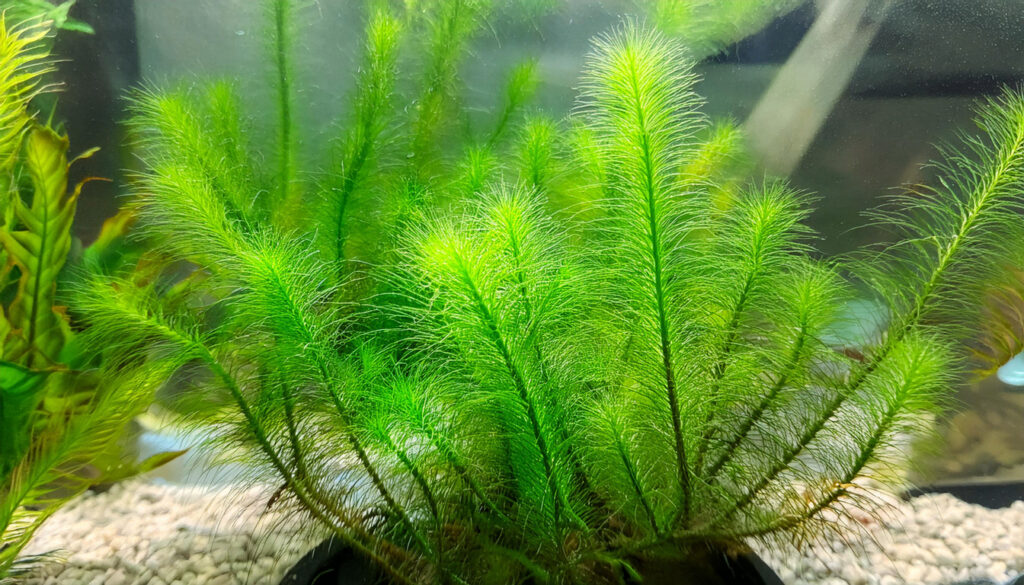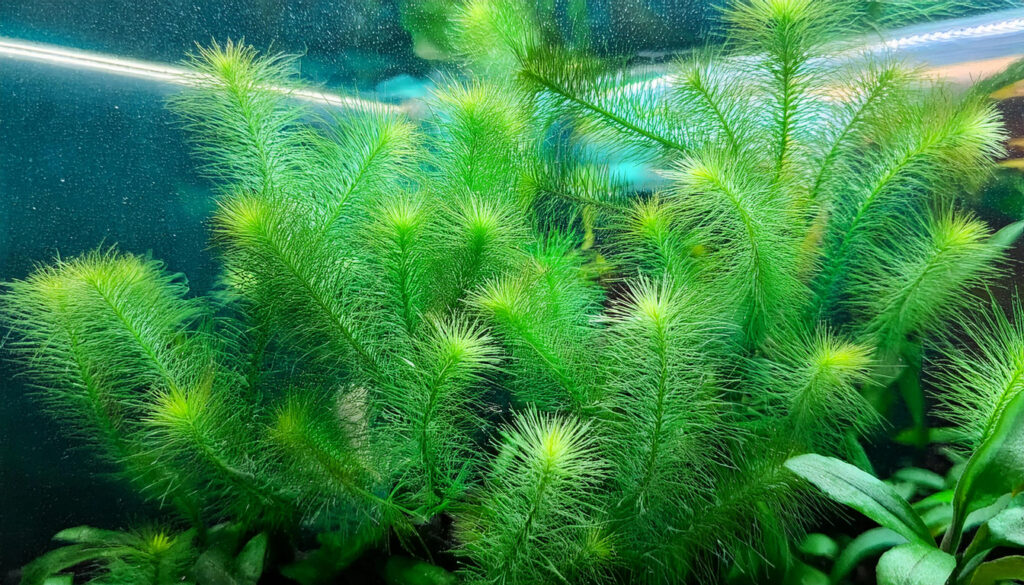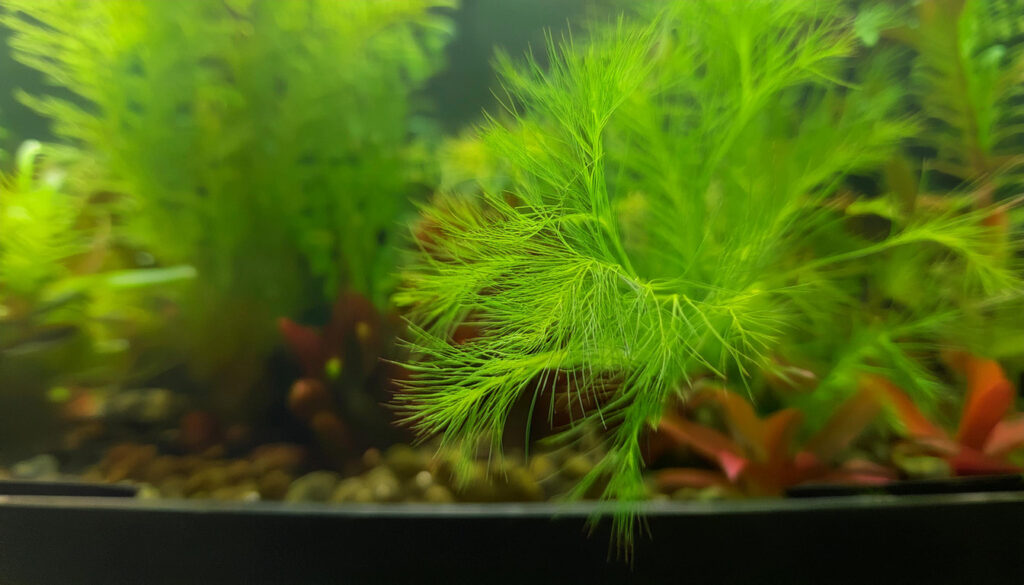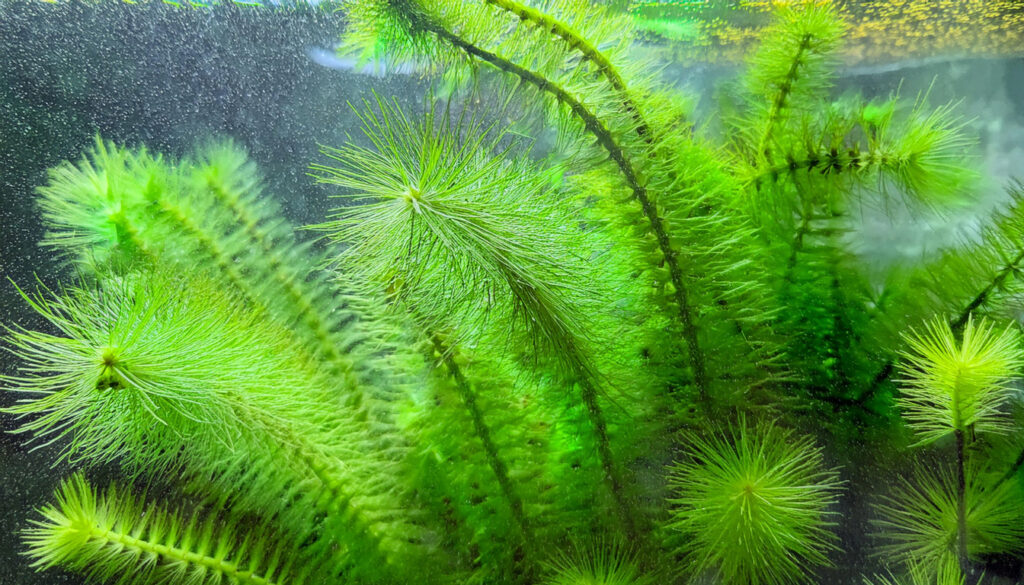Welcome to our complete handbook on Myriophyllum Guyana, a stunning aquatic plant that has captivated the hearts of aquarium enthusiasts.
Whether you’re new to aquatic plants or a seasoned hobbyist, this comprehensive guide is designed to help you cultivate and maintain Myriophyllum Guyana in your underwater landscapes.

Myriophyllum Guyana, also known as Guyana Milfoil, is a popular choice for tropical aquariums due to its vibrant green foliage and compatibility with other freshwater plant species.
This versatile plant thrives in both high-light and low-light conditions, making it suitable for a wide range of aquarium setups.
In this handbook, we will explore the optimal growing conditions for Myriophyllum Guyana, advanced cultivation techniques, and techniques on pruning and propagation.
Additionally, we will provide insights on its native habitat, best practices for transport and acclimatization, troubleshooting common issues, and creative uses in aquascaping and landscaping.
Key Takeaway
- Myriophyllum Guyana is a stunning aquatic plant that enhances the visual appeal of tropical aquariums.
- It can thrive in both high and low light conditions, making it versatile for various aquarium setups.
- Optimizing growing conditions, including lighting, CO2 injection, and fertilization, is crucial for the successful cultivation of Myriophyllum Guyana.
- Pruning and propagation techniques are essential for maintaining the health and shape of Myriophyllum Guyana.
- Understanding its native habitat and geographical distribution can provide valuable insights into its care and maintenance.
Quick Stats
| Attribute | Details |
| Family Name | Haloragaceae |
| Origin | South America |
| Height | 30-60 cm (12-24 inches) |
| pH Range | 6.0 – 7.5 |
| CO2 Requirement | Moderate |
| Growth Rate | Fast |
| Care Level | Moderate |
| Color Form | Bright Green |
| Water Conditions | 22-28°C (72-82°F), adaptable to a range of water hardness |
| Max Size | Can grow tall, up to 60 cm (24 inches), suitable for trimming to desired height |
| Lighting | Moderate to High |
| Supplements | Benefits from CO2 supplementation and liquid fertilizers |
| Placement | Mid-ground to Background |
| Propagation | Stem cuttings |
What Is Myriophyllum Guyana?
Myriophyllum Guyana, scientifically known as Myriophyllum ‘Guyana,’ is a green stem plant that has gained popularity in the aquarium hobby. It is characterized by its smaller form, reaching a diameter of around an inch.
This compact size makes it ideal for shaping into dense, attractive bushes, even in smaller tanks. Myriophyllum Guyana is a versatile aquarium plant that can provide contrast to other non-green plants in your aquatic setup.
Myriophyllum Guyana, also known as Guyana Milfoil, is a freshwater plant species that belongs to the submerged vegetation category. Its vibrant green color and delicate foliage make it a captivating addition to any aquarium.
Whether you are a novice or an experienced aquarium enthusiast, Myriophyllum Guyana is a great choice for creating a visually appealing underwater landscape.

Native Habitat And Geographical Distribution
Understanding the native habitat and geographical distribution of Myriophyllum Guyana is crucial for successfully caring for this aquatic plant.
Native to South America, particularly in areas like Guyana, Suriname, and Brazil, Myriophyllum Guyana thrives in tropical climates and freshwater ecosystems.
Physical Characteristics
- Leaf Structure: The plant features delicate, finely divided leaves arranged in whorls along the stems. Each leaf is pinnately dissected into numerous segments, giving the plant a feathery appearance.
- Stem: The stems of M. guyana are slender and branching, allowing the plant to form dense, bushy growth. The stems may vary in color from green to reddish-brown, depending on environmental conditions and lighting intensity.
- Roots: Like many aquatic plants, M. guyana develops fine roots that anchor the plant in the substrate. These roots also absorb nutrients and contribute to the plant’s overall stability.
- Texture: The foliage of M. guyana has a soft, wispy texture, which adds a delicate and graceful element to aquatic landscapes. When grown in optimal conditions, the plant forms dense clusters that provide shelter and habitat for small aquatic organisms.
- Growth Habit: Myriophyllum guyana typically grows upright or slightly inclined, with stems reaching lengths of up to several inches. Under favorable conditions, the plant can develop dense growth and may require occasional pruning to maintain its shape and prevent overcrowding.
Lighting Conditions
- Proper lighting is essential for the growth and aesthetics of Myriophyllum Guyana. This plant thrives in high-light environments, so provide it with a suitable intensity and duration of light.
- Ensure your aquarium is equipped with quality lights emitting the correct spectrum for optimal plant growth. Regularly assess and adjust the lighting conditions based on the specific requirements of Myriophyllum Guyana.

Temperature Parameter For Robust Growth
- Optimal Range: Myriophyllum guyana demonstrates robust growth when kept within a temperature range of 20 to 28°C (68 to 82°F). This range provides favorable conditions for the plant’s metabolic processes and promotes healthy development.
- Stable Environment: Maintaining consistent temperatures within the recommended range is essential for Myriophyllum guyana’s growth. Fluctuations outside this range can stress the plant, leading to stunted growth or susceptibility to diseases. Use of aquarium heaters or location selection in ponds can help stabilize temperatures.
Optimal Water Condition
- pH: The ideal pH range for Myriophyllum guyana is between 6.5 and 7.5. This slightly acidic to neutral pH range supports nutrient availability and promotes healthy growth.
- Hardness: Moderate water hardness is suitable for Myriophyllum guyana. Aim for a general hardness (GH) level of 4 to 8 dGH and carbonate hardness (KH) of 3 to 6 dKH to provide essential minerals while preventing excessive mineral buildup.
- Temperature: Maintain water temperatures between 20 to 28°C (68 to 82°F) for optimal growth. Consistent temperatures within this range promote healthy metabolic functions and encourage vigorous growth.
- Lighting: Adequate lighting is essential for photosynthesis and overall growth. Provide moderate to high-intensity lighting, typically around 3 to 5 watts per gallon, or adjust lighting duration to simulate natural daylight cycles.
- Nutrient Levels: Ensure the presence of essential nutrients such as nitrogen, phosphorus, and potassium, along with micronutrients like iron and trace elements. Regular water testing and supplementation with a balanced aquarium fertilizer can help maintain optimal nutrient levels.
Substrate Requirement
- Nutrient-Rich Soil: Choose a substrate specifically formulated for aquatic plants or one enriched with nutrients such as iron, potassium, and trace minerals. Myriophyllum guyana benefits from access to essential nutrients through its root system.
- Fine Gravel or Sand: Opt for a fine-grained gravel or sand substrate that provides stability for the plant’s delicate roots. Avoid coarse substrates that may damage the roots or impede their growth.
- Depth: Aim for a substrate depth of at least 2 to 3 inches (5 to 7.5 cm) to allow ample room for root development and nutrient absorption. Deeper substrates may be beneficial for larger aquarium setups or ponds.
- Aquarium Plant Substrate Additives: Consider adding substrate additives such as root tabs or clay-based fertilizers to provide additional nutrients to the substrate. These supplements can enhance plant growth and overall health.

Placement Option
- Foreground Planting: Plant Myriophyllum guyana in the foreground of the aquarium or pond to create a lush carpeting effect. This placement option allows the plant’s vibrant foliage to serve as a visually appealing focal point while providing habitat for small aquatic creatures.
- Midground Planting: Position Myriophyllum guyana in the midground area of the aquarium or pond to add depth and dimension to the aquascape. This placement option allows the plant to complement other foreground and background plants while enhancing the overall aesthetic appeal.
- Background Planting: Use Myriophyllum guyana as a background plant to create a dense, bushy backdrop in the aquarium or pond. This placement option helps fill in empty spaces and provides a natural-looking backdrop for showcasing other aquatic plants and inhabitants.
- Floating Plant: Myriophyllum guyana can also be grown as a floating plant, where its stems and foliage float on the water’s surface. This placement option adds surface coverage, shades the water, and provides refuge for small fish and invertebrates.
Recommended Tank Size
- Consider Growth Potential: Myriophyllum guyana is a fast-growing aquatic plant that can quickly fill out a tank. Therefore, it’s essential to provide a tank size that accommodates its growth potential without overcrowding.
- Space for Root Development: A larger tank offers more substrate area for Myriophyllum guyana’s roots to spread out and establish a strong foothold. This promotes healthier growth and ensures the plant’s stability in the substrate.
- Water Volume and Stability: Larger tanks inherently contain more water volume, which helps stabilize water parameters such as temperature, pH, and nutrient levels. This stability is vital for the overall health and vitality of Myriophyllum guyana and other aquatic life.
- Aquascape Design: The tank size influences the overall layout and design of the aquascape. With a larger tank, you have more space to create visually appealing arrangements, incorporating Myriophyllum guyana as a focal point or part of a larger aquatic landscape.
- Compatibility with Tank Mates: Consider the tank size concerning the species of fish and other aquatic creatures you plan to keep with Myriophyllum guyana. A larger tank provides more room for swimming and territorial behaviors, reducing stress and potential conflicts among tank inhabitants.
RELATED: Eleocharis Pusilla Guide For Proper Care, Tips & Growth
Suitable Tank Mates
- Small Fish Species: Fish such as neon tetras, guppies, rasboras, and small livebearers like endlers are suitable companions. Their small size and peaceful demeanor make them ideal for cohabiting with Myriophyllum guyana without causing damage to the plant.
- Shrimp and Snails: Dwarf shrimp species like cherry shrimp or amano shrimp, as well as small snails like nerite or mystery snails, can safely inhabit the same tank. They help maintain the tank’s cleanliness by scavenging for algae and decaying plant matter.
- Bottom Dwellers: Bottom-dwelling fish like Corydoras catfish or small loaches are compatible tank mates. They occupy the lower levels of the aquarium, leaving ample space for Myriophyllum guyana’s growth along the tank’s mid to upper levels.
- Peaceful Community Fish: Peaceful community fish, such as small tetras, danios, and certain types of barbs, can coexist harmoniously with Myriophyllum guyana. Avoid aggressive or larger fish species that may uproot or damage the delicate stems of the plant.
- Invertebrates: Various freshwater invertebrates like freshwater clams, Malaysian trumpet snails, and small crayfish can thrive alongside Myriophyllum guyana. Ensure that the invertebrates’ care requirements align with those of your aquarium setup.

Essential Nutrients And Fertilization Practices
- To ensure optimal growth and health, providing Myriophyllum Guyana with essential nutrients is important. This aquatic plant requires a balanced combination of macronutrients, such as nitrogen, phosphorus, and potassium, as well as micronutrients, like iron and magnesium.
- Fertilization practices should involve the use of a comprehensive aquatic plant fertilizer specifically formulated for submerged vegetation. Regular testing of water parameters is also recommended to maintain nutrient levels within the ideal range.
Cultivation Tips
- Lighting: Provide moderate to high-intensity lighting for Myriophyllum guyana. LED lights or compact fluorescent bulbs with a color temperature between 6500K to 10000K are suitable for promoting healthy growth. Ensure consistent lighting duration of 8-10 hours per day to support photosynthesis.
- Water Parameters: Maintain stable water parameters within the following ranges: temperature between 68-82°F (20-28°C), pH between 6.5-7.5, and water hardness (GH) between 3-10 dGH. Regular water testing and adjustments are crucial to ensure optimal conditions for plant growth.
- Nutrient Supplementation: Myriophyllum guyana benefits from a nutrient-rich environment. Use a comprehensive liquid fertilizer or root tabs to supply essential nutrients like nitrogen (N), phosphorus (P), potassium (K), and micronutrients. Consider supplementing with additional carbon dioxide (CO2) to support vigorous growth.
- Substrate: Plant Myriophyllum guyana in a nutrient-rich substrate to promote healthy root development and anchorage. Choose a substrate specifically designed for planted aquariums, such as aquasoil or nutrient-rich gravel. A substrate depth of 2-3 inches is sufficient for most setups.
Benefits Of Planting Myriophyllum Guyana
- Natural Habitat: Adding Myriophyllum Guyana creates a naturalistic habitat for aquarium inhabitants, mimicking the lush vegetation found in freshwater ecosystems. It provides hiding places, shelter, and breeding grounds for small fish, shrimp, and other aquatic creatures.
- Aesthetic Appeal: With its vibrant green foliage and delicate, feathery appearance, Myriophyllum Guyana enhances the visual appeal of the aquarium. Its graceful growth pattern and swaying movements in the water add beauty and tranquility to the underwater landscape.
- Biological Balance: By introducing Myriophyllum Guyana, you contribute to the biological balance of the aquarium ecosystem. It forms part of the natural nitrogen cycle, helping to break down organic waste and maintain a healthy environment for aquatic life.
- Natural Behavior Stimulation: Aquatic plants like Myriophyllum Guyana provide natural stimuli for fish behavior, encouraging exploration, foraging, and territorial behaviors. They create a more dynamic and enriching environment, promoting the overall well-being of aquarium inhabitants.
- : In setups with high water flow or where erosion is a concern, Myriophyllum Guyana can help stabilize substrate and prevent soil erosion. Its root system anchors the substrate, reducing the risk of sediment runoff and maintaining the integrity of the aquarium landscape.

Optimizing CO2 Injection
- CO2 injection is crucial for the lush growth of Myriophyllum Guyana. By maintaining optimal CO2 levels, you can enhance the photosynthetic process and promote healthy plant development.
- Consider using a reliable CO2 system and regularly monitor and adjust CO2 levels to keep them within the recommended range for Myriophyllum Guyana.

Troubleshooting Common Issues
- Variations in water parameters: Monitor and maintain stable water temperature, pH levels, and hardness to prevent stress on Myriophyllum Guyana.
- Insufficient lighting: Ensure your aquarium receives adequate lighting, as Myriophyllum Guyana relies on sufficient light for photosynthesis and growth.
- Poor water circulation: Proper water movement is crucial for supplying oxygen and nutrients to Myriophyllum Guyana. If necessary, consider adding a water pump or adjusting your filtration system.
| Pest/Disease | Description | Solution |
| Snails | Small snails that can damage the leaves and hinder growth of Myriophyllum Guyana. | Manually remove snails from your aquarium or consider introducing snail-eating fish species. |
| Algae infestation | Excessive algae growth can hinder the growth of Myriophyllum Guyana by competing for nutrients and blocking light. | Regularly clean your aquarium, maintain proper water parameters, and ensure appropriate lighting levels to prevent algae growth. |
| Plant diseases | Fungal or bacterial infections can affect the health of Myriophyllum Guyana, leading to discoloration and deterioration. | Quarantine affected plants, treat with appropriate anti-fungal or anti-bacterial solutions, and maintain good water quality. |
Conclusion
We have provided a comprehensive guide to the cultivation and maintenance of Myriophyllum Guyana. By following the expert tips and techniques discussed in this article, you can create thriving and vibrant underwater landscapes with Myriophyllum Guyana.
Remember to regularly assess and adjust the growing conditions to ensure this exquisite aquarium plant’s continued health and beauty.
By paying attention to factors such as lighting, nutrition, and trimming, you can maximize the growth potential of this plant and create a stunning aquatic display in your aquarium.
By implementing these maintenance tips, you can enjoy the beauty and benefits of this plant for years to come.
Whether you are a seasoned aquarist or just starting out, the rewarding experience of cultivating and caring for Myriophyllum Guyana is well worth the effort.
We hope this handbook has equipped you with the knowledge and confidence to successfully grow and maintain this remarkable aquatic plant.
RELATED: Unraveling The Helanthium Vesuvius Spirals Of Aquatic Beauty
Frequently Asked Questions
How Can I Propagate Myriophyllum Guyana?
Pruning and propagation are essential aspects of Myriophyllum Guyana cultivation. You can propagate this plant by following a step-by-step guide with techniques to expand your collection or share it with fellow hobbyists.
Additionally, you will learn when and how to refresh your plant for optimal health and vitality.
How Can I Control The Growth Of Guyana Milfoil?
It has the potential for rapid growth, which can lead to invasiveness if not properly managed. To control the growth of Guyana Milfoil, you can follow valuable tips on how to prevent it from becoming invasive in your aquarium.
Implementing these strategies allows you to maintain a balanced and harmonious aquatic ecosystem.
What Are The Best Practices For Plant Health During Transport And Acclimatization?
Ensuring the health of Myriophyllum Guyana during transport and successful acclimatization is crucial for its long-term well-being. You can follow best practices for plant health during transport, including seasonal shipping strategies.
Additionally, you will learn about acclimatization procedures to ensure a healthy introduction of Myriophyllum Guyana to your aquarium.
What Common Issues Can Myriophyllum Guyana Encounter, And How Can I Troubleshoot Them?
Like any living organism, Myriophyllum Guyana may encounter certain challenges and issues. In this section, you will learn how to troubleshoot common problems, such as dealing with environmental stressors, identifying and addressing pests and diseases, and providing solutions for algae growth.
By understanding these common issues and their solutions, you can ensure your Myriophyllum Guyana’s continued health and vitality.
How Can I Incorporate Guyana Milfoil Into My Aquascaping And Landscaping Projects?
It offers unique creative possibilities in aquascaping and landscaping. You can discover various ways to incorporate Guyana Milfoil into your aquatic designs, including designing naturalistic pond landscapes. This section will explore how this plant can elevate the aesthetics of your aquascape or landscape project.
- Unveiling The Wonders Of Riccia Fluitans In Aquascapes - August 7, 2024
- Vallisneria Gigantea Var. Guide To Care And Cultivation At Home - July 31, 2024
- Vesicularia Dubyana Care & Growth Guide Tips For Beginner Gardeners - July 30, 2024
